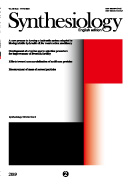Current issue
Displaying 1-8 of 8 articles from this issue
- |<
- <
- 1
- >
- >|
Highlights of the Papers in Synthesiology
-
2021Volume 12Issue 2 Pages i-ii
Published: 2021
Released on J-STAGE: April 21, 2021
Download PDF (576K)
Research papers
-
2021Volume 12Issue 2 Pages 56-74
Published: 2021
Released on J-STAGE: April 21, 2021
Download PDF (4631K) -
2021Volume 12Issue 2 Pages 75-84
Published: 2021
Released on J-STAGE: April 21, 2021
Download PDF (1180K) -
2021Volume 12Issue 2 Pages 85-92
Published: 2021
Released on J-STAGE: April 21, 2021
Download PDF (1151K) -
2021Volume 12Issue 2 Pages 93-109
Published: 2021
Released on J-STAGE: April 21, 2021
Download PDF (2870K)
Editorial board
-
2021Volume 12Issue 2 Pages 110-111
Published: 2021
Released on J-STAGE: April 21, 2021
Download PDF (554K) -
2021Volume 12Issue 2 Pages 112-113
Published: 2021
Released on J-STAGE: April 21, 2021
Download PDF (607K)
Letter from the editor
-
2021Volume 12Issue 2 Pages 114-
Published: 2021
Released on J-STAGE: April 21, 2021
Download PDF (602K)
- |<
- <
- 1
- >
- >|
